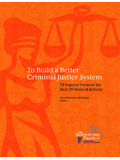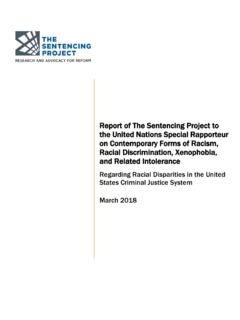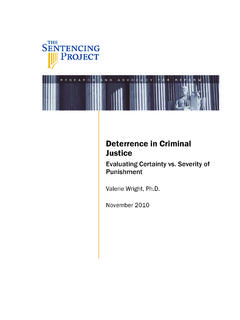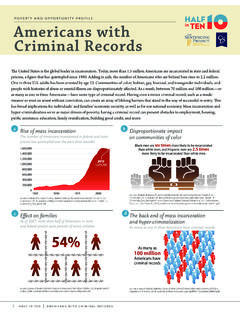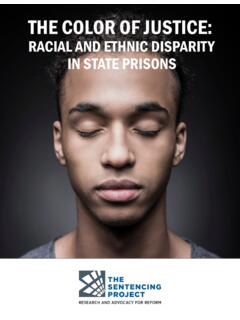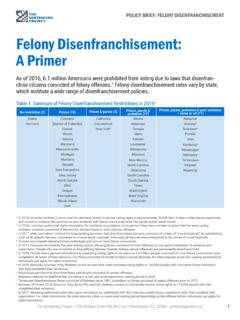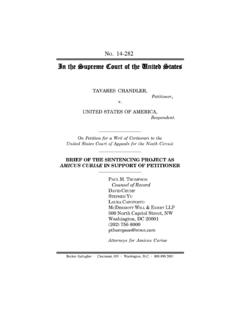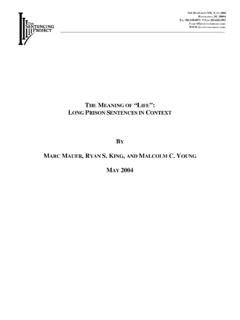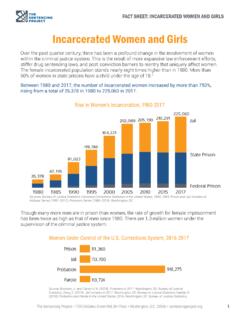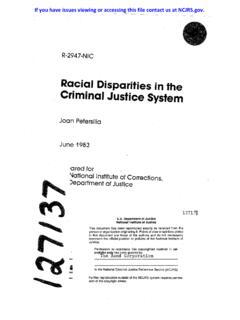Transcription of ELIMINATING RACIAL INEQUITY IN THE CRIMINAL JUSTICE …
1 BLACK LIVES MATTER: ELIMINATING RACIAL INEQUIT Y IN THE CRIMINAL JUSTICE SYSTEMThis report was written by Nazgol Ghandnoosh, , Research Analyst at The Sentencing Project. The report draws on a 2014 publication of The Sentencing Project, Incorporating RACIAL Equity into CRIMINAL JUSTICE photo by Brendan Smialowski of Getty Images showing Congressional staff during a walkout at the Capitol in December Sentencing Project is a national non-profit organization engaged in research and advocacy on CRIMINAL JUSTICE issues. Our work is supported by many individual donors and contributions from the following:Atlantic PhilanthropiesMorton K. and Jane Blaustein Foundation craigslist Charitable FundFord Foundation Bernard F. and Alva B. Gimbel Foundation General Board of Global Ministries of the United Methodist ChurchJK Irwin FoundationOpen Society FoundationsOverbrook FoundationPublic Welfare Foundation Rail Down Charitable TrustDavid Rockefeller FundElizabeth B. and Arthur E.
2 Roswell FoundationTikva Grassroots Empowerment Fund of Tides Foundation Wallace Global Fund Working Assets/CREDOC opyright 2015 by The Sentencing Project. Reproduction of this document in full or in part, and in print or electronic format, only by permission of The Sentencing more information, contact:The Sentencing Project1705 DeSales Street NW8th FloorWashington, 20036(202) Lives Matter: ELIMINATING RACIAL INEQUITY in the CRIMINAL JUSTICE system 1 TABLE OF CONTENTSE xecutive Summary 3I. Uneven Policing in Ferguson and New York City 6II. A Cascade of RACIAL Disparities Throughout the CRIMINAL JUSTICE system 10 III. Causes of Disparities 13A. Differential crime rates 13B. Four key sources of unwarranted RACIAL disparities in CRIMINAL JUSTICE outcomes 15IV. Best Practices for Reducing RACIAL Disparities 19A. Revise policies and laws with disparate RACIAL impact 19B. Address implicit RACIAL bias among CRIMINAL JUSTICE professionals 21C. Reallocate resources to create a fair playing field 23D.
3 Revise policies that exacerbate socioeconomic inequalities and redirect public spending 25toward crime prevention and drug treatmentV. Implementation Strategies and Metrics for Success 26VI. Conclusion 27 2 The Sentencing ProjectBlack Lives Matter: ELIMINATING RACIAL INEQUITY in the CRIMINAL JUSTICE system 3 Every time you see me, you want to mess with me, Eric Garner told the group of approaching New York City police officers. As they wrestled him to the ground to arrest him for selling untaxed loose cigarettes, an officer placed Garner in a chokehold and maintained his grip despite Garner s pleas for air. One hour later, Garner was pronounced dead. The unarmed black man s death and the white officer s non-indictment despite videotape evidence have heightened concerns about police practices and accountability. In the wake of the fatal police shooting of unarmed teenager Michael Brown in Ferguson, Missouri, and that officer s non-indictment, a growing number of Americans are outraged and demanding SUMMARY disparity precede CRIMINAL JUSTICE contact: conditions of socioeconomic inequality contribute to higher rates of some violent and property crimes among people of color.
4 But four features of the JUSTICE system exacerbate this underlying inequality, and jurisdictions around the country have addressed each one through recent Many ostensibly race-neutral policies and laws have a disparate RACIAL policies such as broken windows and stop, question, and frisk have disproportionately impacted young men of color. Prosecutorial policies, such as plea bargain guidelines that disadvantage blacks and Latinos compound these disparities, as do sentencing laws that dictate harsher punishments for crimes for which people of color are disproportionately reform to address this source of disparity in policing is the significant retrenchment of stop and frisk in New York City after a court ruled that the policy violated the constitutional rights of blacks and Latinos. Recent legislation reducing the sentencing disparity between the use and distribution of crack versus powder cocaine in California, Missouri, and at the federal level are examples of efforts to tackle sentencing inequalities.
5 Black lives matter has become a rallying cry in light of evidence that the CRIMINAL JUSTICE system is failing to uphold this basic truth. Official data, although woefully inadequate,1 show that over half of those killed by police in recent years have been black or Officers involved in these killings are rarely indicted, much less convicted, for excessive use of And official responses to recent protests have spurred further controversy: militarized police forces disrupted public assemblies in Ferguson,4 and New York City s police union blamed pro-reform politicians and nonviolent protesters for the killing of two officers by a mentally unstable CRIMINAL JUSTICE system s high volume of contact with people of color is a major cause of African Americans disproportionate rate of fatal police encounters, as well as of broader perceptions of injustice in many communities. This briefing paper identifies four key features of the JUSTICE system that contribute to its disparate RACIAL impact, and presents recent best practices for targeting these inequities drawn from adult and juvenile JUSTICE systems around the country.
6 In many cases, these practices have produced demonstrable is by no means the only stage of the JUSTICE system that produces RACIAL disparity. Disadvantage accumulating at each step of the process contributes to blacks and Latinos comprising 56% of the incarcerated population, yet only 30% of the The roots of this 4 The Sentencing Project2. CRIMINAL JUSTICE practitioners use of discretion is often unintentionally influenced by RACIAL disparities in traffic stops have diminished on a nationwide basis in recent years, but persist in many jurisdictions. Police officers are more likely to stop black and Hispanic drivers for investigative reasons. Once pulled over, people of color are more likely than whites to be searched, and blacks are more likely than whites to be arrested. In jurisdictions like Ferguson, these patterns hold even though police have a higher contraband hit rate when searching white versus black drivers.
7 Prosecutors and judges also often treat blacks and Hispanics more harshly in their charging and sentencing Vera Institute of JUSTICE s work with prosecutors offices around the country is one initiative addressing bias in charging decisions by monitoring outcomes and increasing accountability. Similarly, judges in Dorchester, Massachusetts, have worked with police and prosecutors to develop guidelines to reduce RACIAL disparities in charging enhancements for people arrested for drug crimes in a school Key segments of the CRIMINAL JUSTICE system are underfunded, putting blacks and Latinos who are disproportionately low-income at a disadvantage. Most states inadequately fund their indigent defense programs. Pretrial release often requires money bond, which can be prohibitive to low-income individuals and increases the pressure on them to accept less favorable plea deals. Many parole and probation systems offer supervision with little support.
8 Public drug treatment programs are also underfunded, thereby limiting treatment and sentencing alternatives for low-income individuals. New Jersey s recently overhauled bail laws, which will increase nonmonetary release options, is an effort to create a more even playing field for low-income individuals. In Illinois, the expansion of alternative community programs has helped to nearly halve reliance on secure detention for youth. 4. CRIMINAL JUSTICE policies exacerbate socioeconomic inequalities by imposing collateral consequences on those with CRIMINAL records and by diverting public spending. A CRIMINAL conviction creates a barrier to securing steady employment, and those with felony drug convictions are disqualified from public assistance and public housing in many areas. In addition, allocating public resources to punitive programs comes at the expense of investments in crime prevention and drug treatment programs.
9 Because of their higher rates of incarceration and poverty, people of color are disproportionately affected by these policy key development in this area is California s reclassification of a number of low-level offenses from felonies to misdemeanors under Proposition 47 in 2014. This initiative is intended to reduce prison admissions and to spare many low-level offenders the collateral consequences of a felony conviction. The law also redirects a portion of state prison savings estimated to be $150-$250 million annually to crime prevention and drug treatment high-profile killings by police officers demonstrate the need for better police practices and improved accountability. They also underscore the need for revising policies that place people of color under greater police scrutiny and that lead to their disadvantage throughout the CRIMINAL JUSTICE system .
10 To address this crisis of confidence, especially among people of color, CRIMINAL JUSTICE practitioners and policymakers should seize this opportunity to adopt and expand upon existing best practices for promoting RACIAL equity at all levels of the JUSTICE briefing paper is organized as follows: Section I examines RACIAL disparities in policing in Ferguson, Missouri, and New York City. Section II compares these patterns with nationwide trends and relates them to disparate outcomes at later stages of the CRIMINAL JUSTICE process. Section III examines the causes of blacks and Latinos overrepresentation in the JUSTICE system , Black Lives Matter: ELIMINATING RACIAL INEQUITY in the CRIMINAL JUSTICE system 5including differential crime rates and the four sources of inequities in the JUSTICE system . Section IV presents best practices from around the country for reducing RACIAL disparities created by these four sources.
